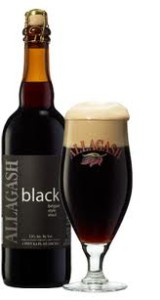 Lots of dark, rich beer connect their branding to the colour black. Fair enough. It is accurate, evocative and simple as a drawing card. The only thing is that lots of different things can be going on inside the bottle – everything from a coffee stout to a Russian Imperial to a deep barley wines.
Lots of dark, rich beer connect their branding to the colour black. Fair enough. It is accurate, evocative and simple as a drawing card. The only thing is that lots of different things can be going on inside the bottle – everything from a coffee stout to a Russian Imperial to a deep barley wines.
When I was in Boston two summers ago (you can read a post about it here) I, of course, brought home a bunch of beer. One I had not yet gotten around to sampling was Allagash Black. Allagash is a highly respected Maine brewer probably best known for their witbier, Allagash White (rather chromatic, those boys are). Allagash Black seems to create a bit of confusion as to where to classify it. The brewery called it a Belgian-style stout. Others have placed it as a foreign stout, as a Russian Imperial Stout or even as a Belgian Strong. Alas, it doesn’t fit in any of those categories.
I believe it is that most North American beer drinkers are unfamiliar with the style of Belgian Stout, in terms of its name. There certainly are other examples around, including Struise Pannepot, so it is not an entirely alien concept (Pannepot is also often mislabeled). I just think we haven’t got our heads around it yet.
Fortunately (for me, anyway) I have become somewhat familiar with the style. One of my biggest discoveries on my 2007 trip to Belgium was a little-known beer called Hercule Stout – a classic Belgian Stout. I enjoyed it so much I make my friend who currently lives in Brussels bring me a couple of bottles every time she comes home (very sweet of her!). So a couple times a year I get to savour the inky complexity of Belgian Stout.
To be clear, Belgian Stouts are deep, black stouts with a higher alcohol content and brewed with Belgian-style yeasts, creating, a sharper beer with the requisite Belgian spiciness and funkiness.
The bottle of Allagash Black I possess(ed) has been sitting in my cellar for about 16 months – so it is closing in on two years old. At 7.5% I might normally be a bit nervous at leaving it that long, but the Belgian yeast strain and bottle fermentation should have extended its life nicely. Meaning this winter was likely the perfect time to try it. And so try it I did.
As expected it presents deep black, producing a huge light tan head with tight bead and good consistency. I am impressed just how slow the head is to dissipate, still giving me a nice look near the end of the glass.
My nose picks up dark raisin, plum, earthy chocolate, hints of yeast spiciness, a bit of chocolate and mocha. The aroma seems sharper than most stouts. In the flavour, dark fruit, raisin and plum, start things up. Then some bitter chocolate and mild roast kick in. Anchoring it all is a funky earthiness, creating an almost sour note, but not lactic. Instead it is pungent and complex, quite dry and musty. Undernotes of licorice, phenolic pepperiness and whiskey add accent. The mouthfeel reveals a bit of alcohol heat. The beer finishes dry with a sharp musty linger.
Allagash Black is a complex beer that provides a ninety degree turn from a regular stout. Sure there is some stout under there, but the yeast transforms the beer. Its funky and peppery sharpness mixes in with soft roast and other stout qualities. True stout fans will be disappointed and I speculate that Belgian traditionalists may also frown, but I know a good Belgian Stout when I taste one. It doesn’t knock Hercule Stout off the thrown for me, personally, but a very nice change of pace over regular stouts.
And surely deserving of the simple, descriptive name of black.

Leave a Reply